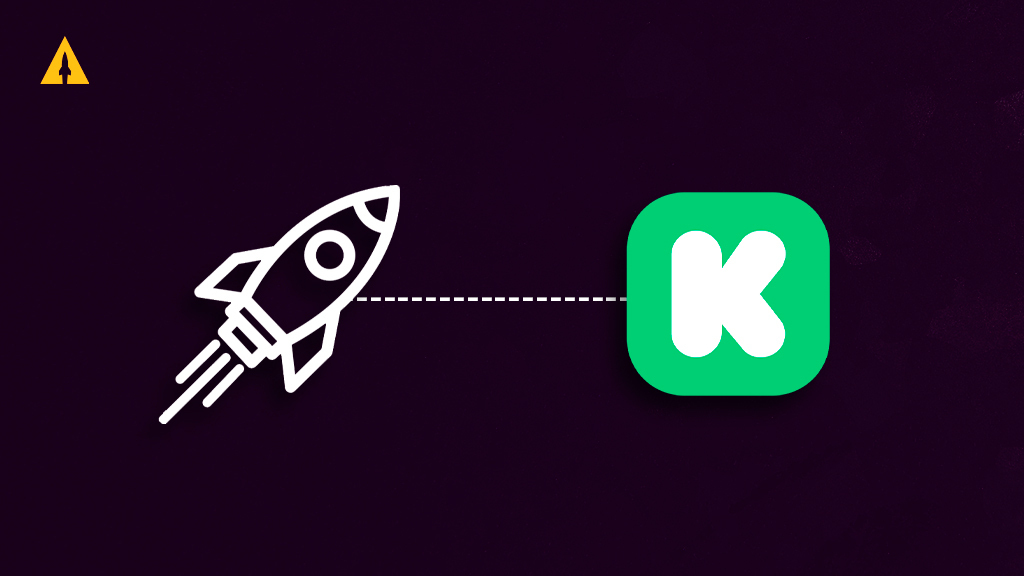
We talk a lot about how difficult it is to hit $1M dollars in crowdfunding. How difficult? It’s so rare that only 1.8% of campaigns hit $100K, and only 0.12% of Kickstarter campaigns ever break the seven-figure ceiling.
And while we feel it’s best to manage the expectations of crowdfunding newcomers by being upfront about this statistic, we want to stress that even though financial results may differ between campaigns, LaunchBoom’s crowdfunding process remains the same for all. Whether it’s hitting a modest goal that helps to launch your small business or shattering $1M in 24 hours, the key to success lies in the “how.”
In this Kickstarter case study we’ll examine how the LaunchBoom system helped a startup raise $1M in 24 hours. Polycade — a modular arcade company — made $1,050,872 on the first day of their recent Kickstarter campaign. We’ll break down the steps they took that you can apply to your own campaign no matter your product type, size of your budget, or desired funding goal.
Contents
- Biggest challenges of crowdfunding for startups
- Understanding Polycade’s journey before LaunchBoom
- Pre-launch: How we built the campaign
- Launch: How we launched the campaign
- Post-launch: How we measured and learned from the campaign
- 3 proven strategies for startup clients
- Final thoughts
- How LaunchBoom helped a startup raise $1M in 24 hours: Frequently asked questions
Biggest challenges of crowdfunding for startups
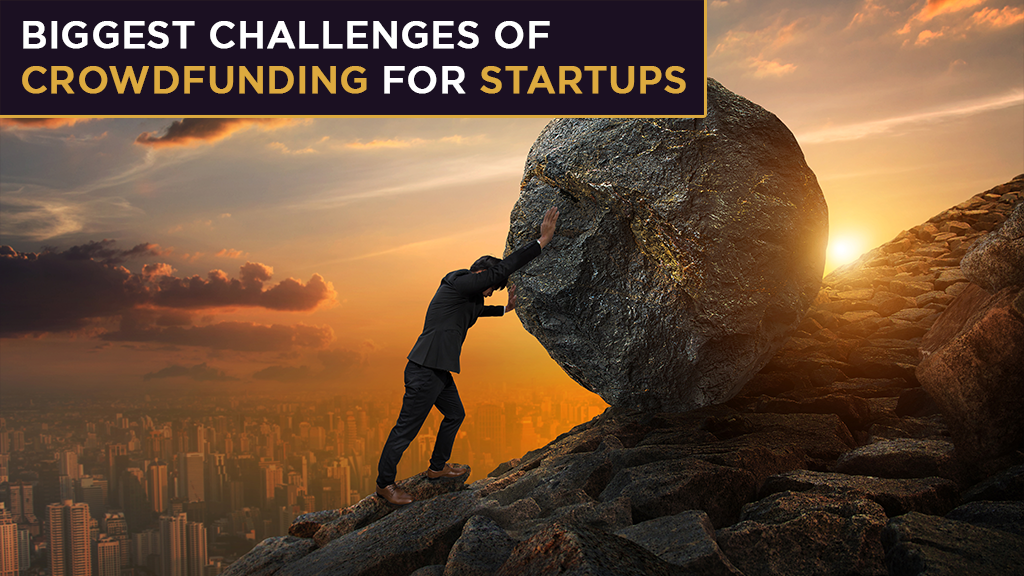
There are plenty of challenges for startups getting into crowdfunding, but knowing what lies ahead is key for gaining the confidence needed to start. We call this: adopting the “creator mindset.”
Adopting the creator mindset is all about being able to overcome limiting beliefs. We define limiting beliefs as internal obstacles, like convincing yourself you don’t have enough time, you don’t have the right team, or the dreaded imposter syndrome.
But even when you’re able to set those internal arguments aside, there are still some tangible challenges to know about before reaching crowdfunding success.
Competing in a crowded market
There are bound to be campaigns in your product category who will be directly competing against you while you’re live. Having total belief in your product over theirs is great, but it’s best to validate those beliefs before you start.
Product validation is done through careful market research. Even if you see that it’s a crowded market in your product category, you can still gather concrete data proving that there’s an audience who will back your product.
This starts by being able to find your target audience.
Finding your target audience
One of the biggest challenges creators often face is figuring out how to reach their audience. You know how great your product is, but people aren’t naturally going to back your product — or even find your campaign — if you don’t bring it to their attention first.
Finding your target audience starts with great product positioning. We define great product positioning as being able to communicate the value of your product to your target audience. If your product is solving problems that people commonly experience when using similar products, you better make that abundantly clear to potential backers.
Once you find those potential backers, you’ll have to gain their trust.
Gaining audience trust
The inability to gain audience trust is a crucial mistake that can lead to a high chance of campaign failure. The way to gain trust is through a combination of various factors, including good communication, strong visual assets, and having the right kind of funnel in place for your product.
With a properly constructed reservation funnel, you can quantify exactly how much trust you’ve built with your audience. Having this data in pre-launch is the most significant indicator on whether your campaign will be a success or not. Creators who aren’t able to measure audience trust will have major problems hitting their funding goal, let alone a $1M dollar raise in the first day.
So, how was Polycade able to overcome these common hurdles and achieve mind-blowing results in crowdfunding? Believe it or not, it wasn’t something that came easily.
Understanding Polycade’s journey before LaunchBoom
Raising $1,050,872 in the first 24 hours of a crowdfunding campaign is a massive achievement and it gives the impression of an overnight success. However, Polycade’s story starts long before their partnership with LaunchBoom, and their success was anything but.
Their story starts with Tyler Bushnell, the creator of Polycade Sente.
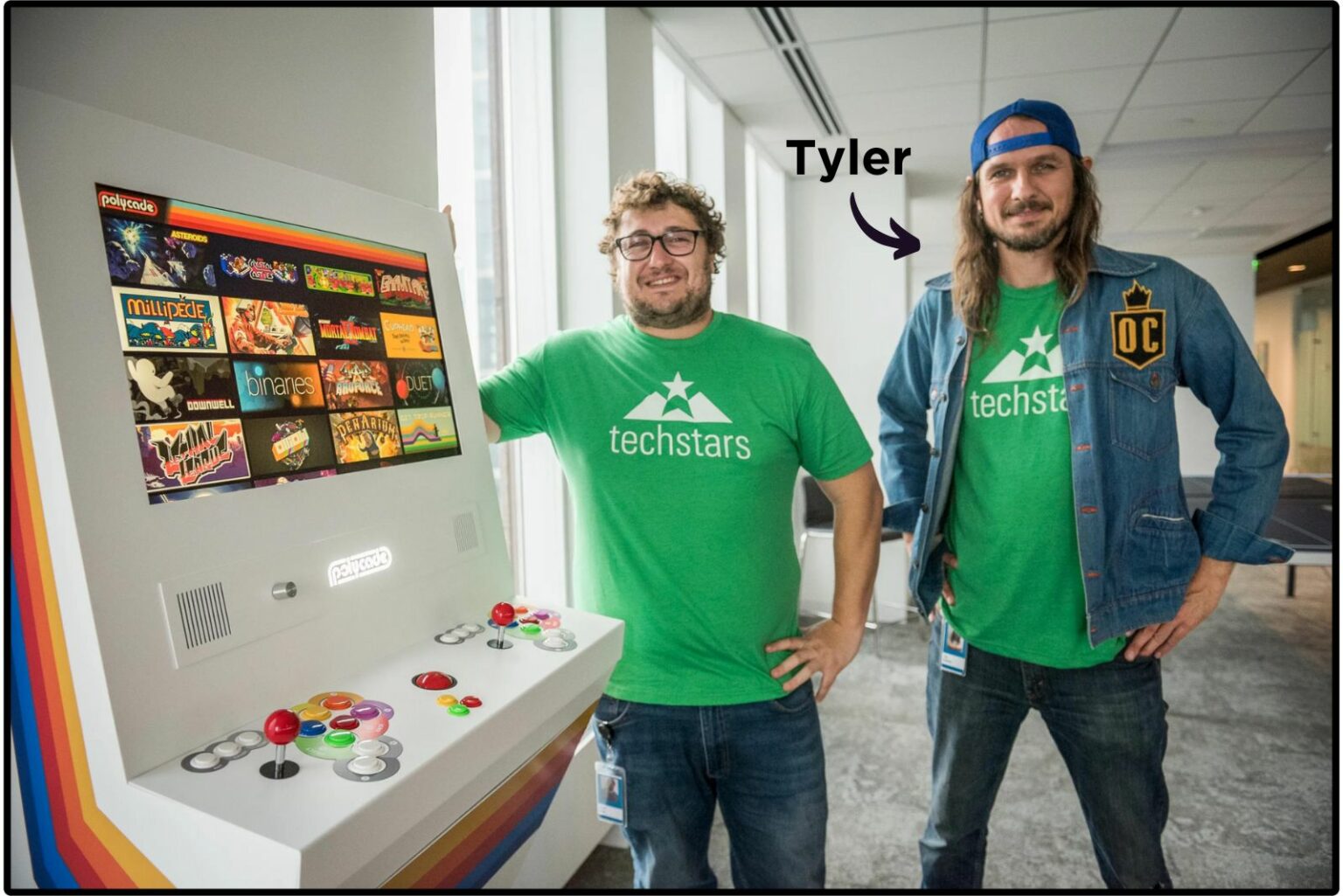
Tyler is the son of the founder of Atari and was surrounded by classic video games his whole life. As an engineer himself, his passion for playing retro games led him on a path to finding the best solution for playing them in the most optimal way possible. That solution was the Polycade.
The Polycade version 1 — predecessor of the Polycade Sente — was launched on Kickstarter in 2015 and raised a total of $125,276. While Tyler would admit that the marketing they did for their first campaign wasn’t the best, the initial campaign ended up being a success for the startup, helping him to manufacture that version of the product and get it into the hands of arcade aficionados.
You might be asking: How does someone go from a $125,276 launch of version 1 to breaking $1M eight years later?
The years between the first launch and the most recent one for the Polycade Sente were full of valuable lessons. From manufacturing mistakes, to the gradual discovery of version 1 design flaws, to a failed second crowdfunding campaign, Polycade proved that there’s more that goes into a million dollar raise than what we see on the surface.
One of the biggest revelations in the time before the Polycade Sente, was the demand for something modular. They had already created something modular on the software side, since the games could be customized to fit the user, but they realized through constant audience engagement that there was still a need they could fill. That need was for hardware and aesthetic modularization.
They decided it was time to take their new design to crowdfunding once more, but this time they wanted to leave nothing on the table. Enter LaunchBoom.
Pre-launch: How we built the campaign
All campaigns are won in the pre-launch, and the Polycade Sente is no exception.
When asked about what they did pre-launch for their first campaign, they told us that the extent of their marketing was reaching out to bloggers to announce their product. Thankfully, it worked for them, but not everyone has built-in recognition as the son of the man who built the Atari. We knew the LaunchBoom system on top of that would have some incredible results. Let’s look at their pre-launch marketing strategy.
The main driver of campaign traffic is an email list full of people who can’t wait to buy your product. We built their list using our reservation funnel system.
The first customer touchpoint for this funnel was a Meta ad. Here’s what the best performing ad looks like:
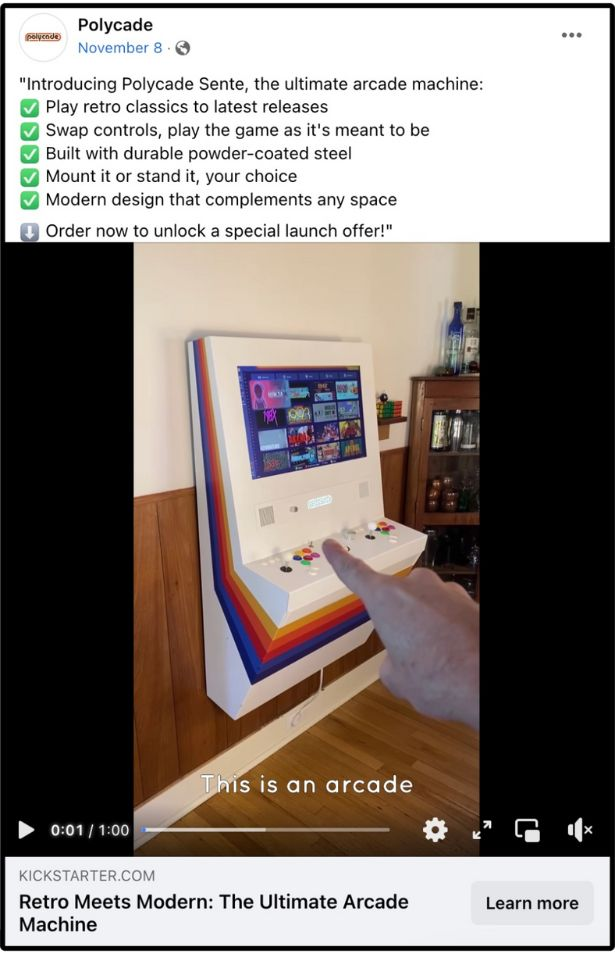
Just like the arcade machine is modular, Meta ads are as well. We tested several variations of this ad, swapping in different headlines and features to highlight in order to find out which ones resonate best with the target audience.
Once a potential backer was interested in the ad, we collected their email address via a landing page.
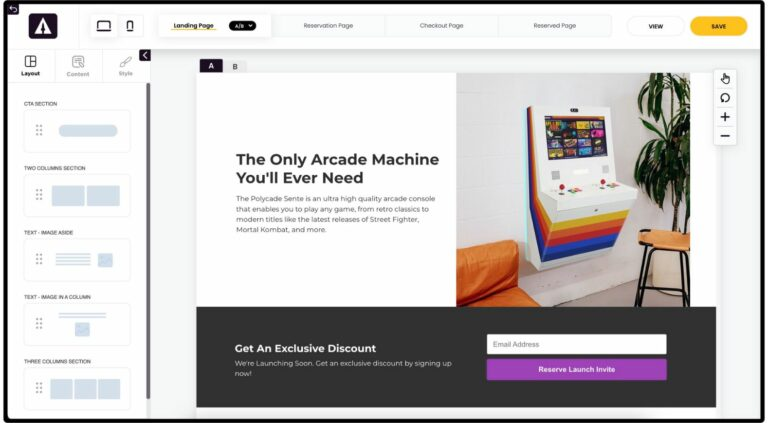
The first thing users see is a powerful headline that communicates the deepest value of the Polycade Sente, as well as a clean image of the product displayed where the target customer would likely want to house it: in the living room amongst their furniture.
Using a minimalist design to reflect the product itself, the landing page was a chance to teach customers more about the product while encouraging them to join the email list for an “Exclusive Discount” with a call-to-action section at the bottom of the screen.
When potential backers felt strongly enough that they wanted to be there on launch day to take advantage of the discount, that’s when we collected the $1 deposit to finalize their reservation. Here were the perks associated with the $1 deposit, which any creator can customize for their campaign:
- A guaranteed 50% discount
- A limited-edition game with artwork by a modern artist
- An invite to Polycade’s VIP Facebook group
Once we collected enough reservations to indicate Polycade would have a successful launch, we moved forward with the campaign.
Launch: How we launched the campaign
The best thing about the $1 reservation deposit, is that it has proven that people who pay it are roughly 30 times more likely to back the product once the campaign goes live. Once we had a list of 2,362 people who paid the deposit, it was time to launch.
Here’s a look at the numbers from their first 24 hours:
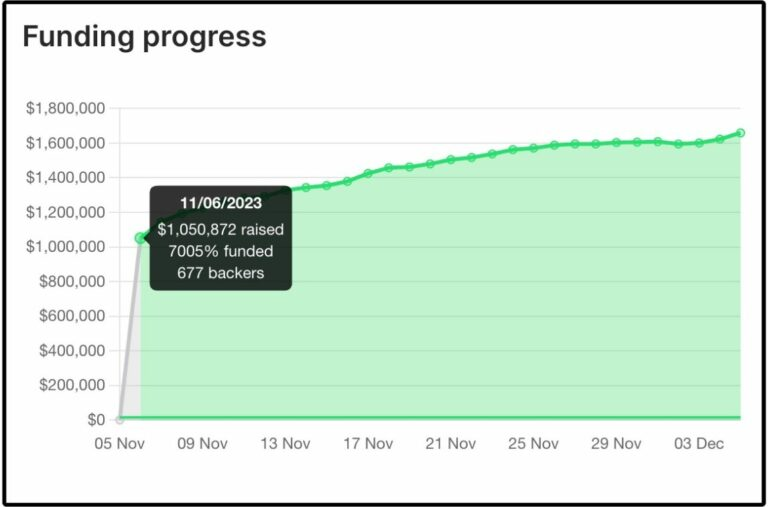
Polycade raised a mind-blowing $1,050,872 from 677 total backers on their first day. Remember that the number of deposits was 2,362, meaning that 28% of the list bought their product on launch day.
Thanks to this enormous raise, Kickstarter gave the Polycade Sente campaign extra exposure to other users of the platform, which brought in new traffic organically to the campaign page. This extra boost from Kickstarter is one of the reasons why it’s important to try and have a big first day.
For the remaining duration of the campaign, we continued to help them manage their ad spend due to the potency of running Meta ads for a digital marketplace. As the campaign progressed, Polycade introduced new discounts and incentives for people who haven’t backed yet in order to further drive sales and finish strong.
Post-launch: How we measured and learned from the campaign
In the end, the campaign went on to raise $1,658,958 in revenue from 969 backers. Crucially, the Polycade team saw a 25.47x return on pre-launch ad spend. This revelation helped the creator, Tyler, see the advantages of spending resources on ads. In fact, he was so convinced about the value of digital ads that he and his team completely skipped out on what they relied on in their first campaign: leveraging influencers to drive traffic.
Another important revelation for us and the Polycade team was just how much marketing power lies in the hands of the product creators. Often, creators think they need to rely solely on crowdfunding marketing services, but nobody truly knows the product like the ones who made it.
Using their best performing ad as an example, much of its success relied on a video shot and edited by Tyler where he gave a short tutorial of the Polycade Sente. His passion and knowledge of the product were able to communicate value to viewers better than any third-party agency could, which is a big reason why they made 25.47x return on pre-launch ad spend.
3 proven strategies for startup clients
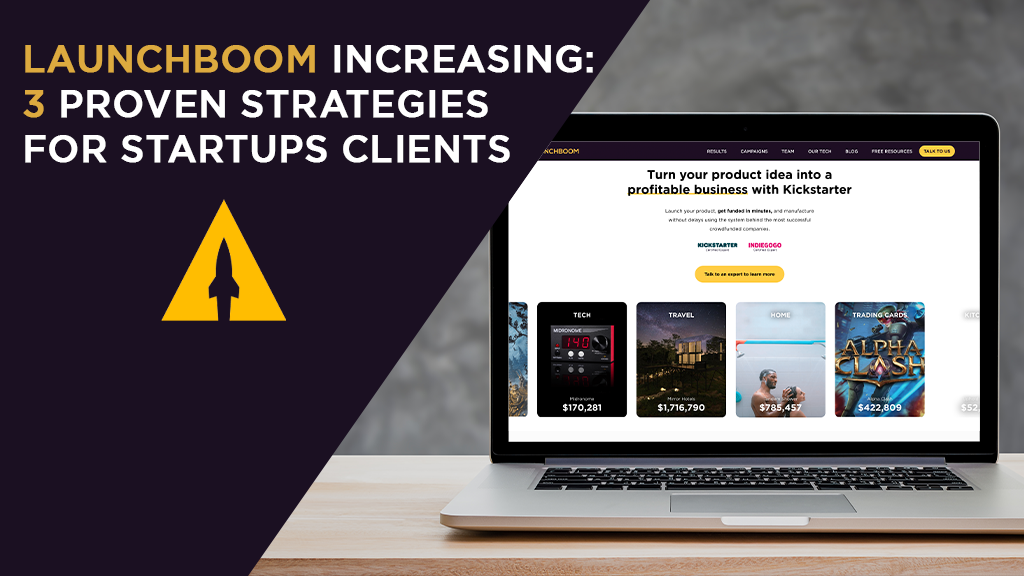
Now that you know what worked for Polycade, we can reiterate some of the proven methods for startup clients that can work for your campaign, whether you’re the son of a famous videogame figure or not.
These are some of the key strategies of how LaunchBoom used to help a startup raise $1M in 24 hours.
1. Drive traffic with an easy-to-use landing page
We can’t stress enough that the landing page you design for your reservation funnel should be very easy to use for potential backers. You want to aim for something that’s simple, isn’t a wall of scrolling, and effectively guides people to take an action.
The actions you want them to take are one of two:
- Become a Non-VIP by only providing an email address to stay informed about the upcoming campaign, or
- Become a VIP by giving their email address and placing at least a $1 deposit
Using the deposit system gives creators much more ability to forecast the success of a campaign.
2. Work with reservations
Using reservations as a key metric, it’s easy to quantify their effectiveness in relation to marketing for a crowdfunding campaign. Let’s break this idea down further.
If you have 100 VIPs and 900 non-VIPs, we can use our data-backed expected conversion rates to demonstrate the expected number of sales.
- For VIPs: 100 x 30% = 30 expected sales
- For non-VIPs: 900 x 1% = 9 expected sales
Knowing your expected sales, you can then start to calculate average order value, or total revenue divided by the total sales over a certain time period. Average order value stays in a range of 1.25x to 1.5x the lowest price point of a product. Using your most discounted price, you can multiply it by 1.25 to get your expected average order value. For example:
- For VIPs: 30 sales x $500 lowest price = $15,000 expected revenue
- For non-VIPs: 9 sales x $500 lowest price = $4,500 expected revenue
- Total expected revenue: $19,500
Once you know your total expected revenue, you can also calculate your expected return on ad spend (ROAS). You can even apply these figures toward calculating the effectiveness of a given ad!
If you project that you want to spend up to $4,000, you would divide the total expected revenue by this project ad spend to get $4.88 — the amount you earn for every dollar spent on ads.
This foundation of data can also be applied to the ads you want to run, so you can test your way to the optimal ad strategy for your target audience.
3. Ads strategies
It’s hard to know if an ad is good, which is why our strategy revolves around using the data to tell us. Using hard data, like how many people are putting down reservations as a result of clicking on an ad, you can see what creative has a higher likelihood of driving more revenue.
We recommend testing different variables like copy, imagery, and audiences to find the best vehicle for the results you want. Once you have the winning ad, continue running it and drop the ones that had weaker results. From there, you can create a new test to optimize a different variable using your strongest ad as the standard.
Systematically testing product positioning in this way helps you learn what people are responding to. If you aren’t getting the results that indicate a successful campaign, you can use this data as your hedge against certain failure.
The LaunchBoom ad strategy has the added benefit of teaching you what people are most interested in a product like yours. Remember, it wasn’t until Polycade stumbled across a demand for modular parts in their social media comment sections that they got the idea to launch their million dollar product.
Final thoughts
The overnight successes in crowdfunding are romantic ideals to strive toward, but there’s potentially greater value in studying startups like Polycade who spent nearly a decade developing their ideas and products. We all want to wake up one morning with a million-dollar idea, but the reality is that’s most likely not going to happen.
If you’re a small business, it really doesn’t matter where you are in your company’s journey, we believe that crowdfunding is a viable option for your next product launch. But don’t make the mistake of going at it alone. LaunchBoom is here to help.
To learn more about LaunchBoom costs, as well as how we can help you achieve crowdfunding success, click here to set up an appointment with us today.
How LaunchBoom helped a startup raise $1M in 24 hours: Frequently asked questions
What are the best crowdfunding sites for startups?
The best crowdfunding sites for startups are Kickstarter and Indiegogo. Both come with their own sets of advantages and disadvantages, and can vary in effectiveness depending on what product category you are in. To learn more, check out this in-depth guide on Kickstarter vs. Indiegogo.
Can you fund a startup retail business using crowdfunding?
Kickstarter is an excellent option for business startups whose end goal is selling retail via e-commerce. Once you’ve validated that there’s demand for your product with a successful campaign, and after you’ve fulfilled your first round of orders, it’s then possible to scale your business and make the transition to e-commerce.
What challenges can a startup face during the fundraising process?
Some of the common challenges a startup will face in crowdfunding are competing in a crowded market, not being able to find the right target audience, and not thoroughly gaining that audience’s trust. Not addressing these concerns before committing to a crowdfunding launch can lead to campaign failure.
What are the main advantages for other startups looking to raise $1 million in 24 hours?
The biggest advantage of $1 million dollar raises is that they emphatically prove the demand for a product. When handled correctly, they can be leveraged into faster growth and revenue scaling. When handled poorly, they can have an adverse effect on audience trust, which can create a negative image around a brand before it has a chance to grow further.
Just remember, not every campaign needs to raise $1M dollars to be a success.



